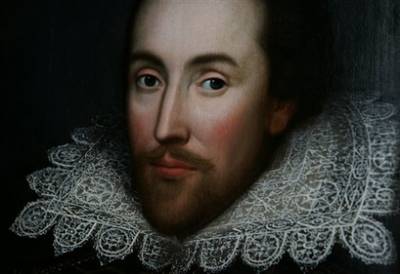There is a lot of noise in the press today about the unveiling of a portrait that is now believed to be of William Shakespeare (see here, here, here, here, or here). The painting is believed to be the original source for the only two surviving likenesses of Shakespeare from his era, both of which were produced in the decade after his death. This painting, inherited by the descendants of the playwright's patron, is believed to have been painted in Shakespeare's lifetime.
 Image credit: AP Photo/Lefteris Pitarakis
Image credit: AP Photo/Lefteris Pitarakis
There is no definitive proof to show that the painting is unquestionably of Shakespeare. The evidence includes its association with the family of Shakespeare's patron, its supposed resemblance to existing portraits, and the results of "scientific testing" and the nebulous testimony of "experts" who are quoted as being "90% certain" that this is a portrait of Shakespeare. The articles also rely heavily on the ethos of Stanley Wells, noted Shakespearean scholar and chair of the Shakespeare Birthplace Trust. (But as one of the commentators on the NYT blog entry notes, Wells is responsible for the inclusion of Edward III in the Oxford Shakespeare, a decision that has been met with considerable skepticism among Shakespeare scholars.)
I wouldn't exactly say that I'm skeptical of the claim that this is a portrait of Shakespeare. But I am interested in the extent to which the reception of the portrait is shaped by everyone's apparent desire for this to be a portrait of Shakespeare. In the absence of definitive proof either way, everyone seems to have decided that it's simply more exciting to assume that it is than to be circumspect about whether it could be. Further, it's interesting to consider how the particular details of this story brings to life many of the fantasies of Shakespeare biography and criticism. The longstanding desire to discover Shakespeare's "lost" works--an event that would establish the critic as a celebrity of some standing among Shakespeareans--is often imagined as peeling an old playtext off the back of an abandoned painting in a dusty antique shop. In this case, life imitates art (or fantasy).
UPDATE: Today there is a wonderful little item on the painting in the NYT, with the following question:
We somehow want the young Shakespeare to look like Joseph Fiennes, fiery and slashing. But what if he looked like Ricky Gervais? Would the plays mean less to us?
 Image credit: AP Photo/Lefteris Pitarakis
Image credit: AP Photo/Lefteris Pitarakis
Recent comments
2 years 29 weeks ago
2 years 44 weeks ago
2 years 44 weeks ago
2 years 50 weeks ago
3 years 4 weeks ago
3 years 4 weeks ago
3 years 4 weeks ago
3 years 6 weeks ago
3 years 6 weeks ago
3 years 6 weeks ago